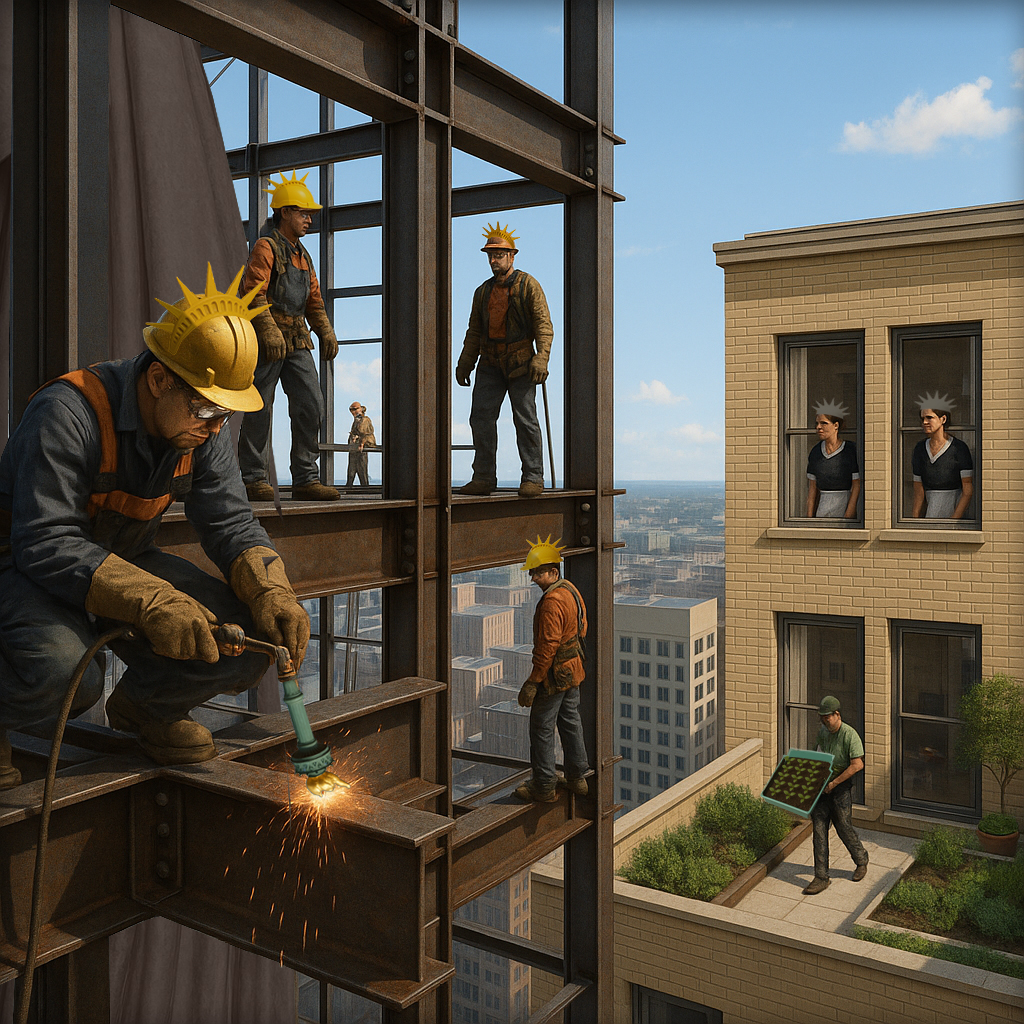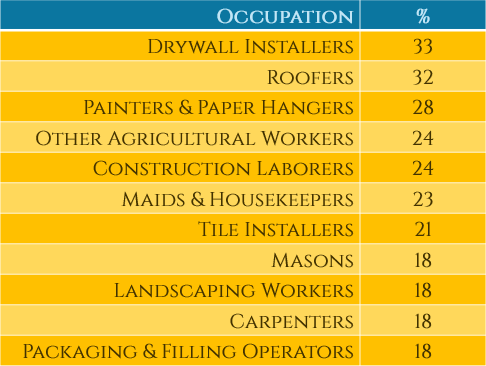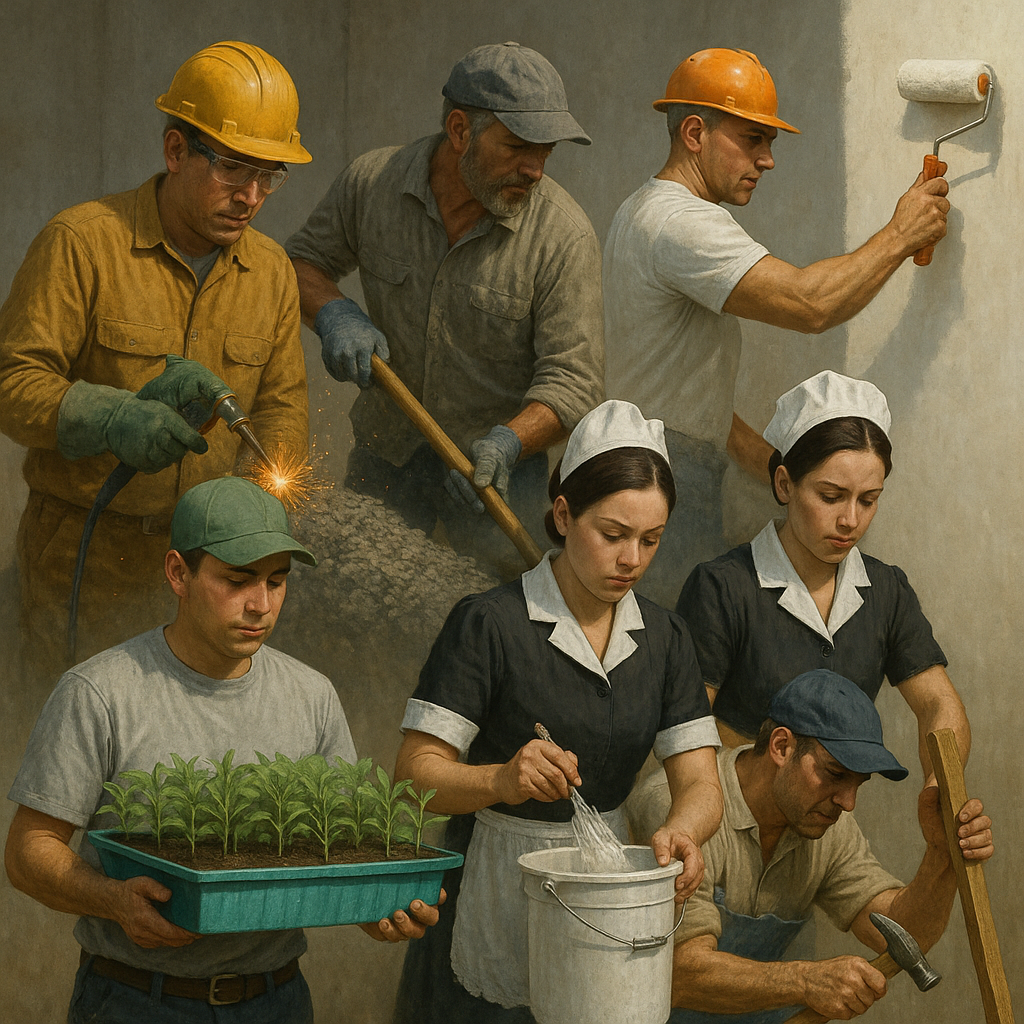
A Day to Celebrate American Workers–and Immigrants
 By Frank F Islam & Ed Crego, August 28th, 2025 (Image credits: Tom de Boor, JNCGPT50)
By Frank F Islam & Ed Crego, August 28th, 2025 (Image credits: Tom de Boor, JNCGPT50)
Labor Day is a day to celebrate all workers and all forms and levels of work.
That was the opening line of our Labor Day blog last year. Because of the American performance in the Olympics in 2024, we focused on celebrating the work of the American athletes, and the connection between their Olympic spirit and the spirit of those American workers “committed to excellence in all lines of work.”
We went on to state that those workers:
… are on the playing field and the battlefield; on the shop floor and in the office, in the classroom and the operating room, in small businesses and big businesses; in union companies and non-union companies; in the private sector and the public sector.
This Labor Day we will celebrate those workers again, and recognize the contributions that immigrants have made to our American workforce and nation in the past, are making today, and will make in the future.
Immigrants and the American Workforce: The Past
America is an immigrant nation — and has been from its founding. When America began shifting from an agrarian economy to an industrial economy in the last half of the 19th century, immigrants were central to doing some of the hardest labor required of the American workforce and participated in developing the labor movement.
The Pew Research Center notes in its piece on immigration’s impact on the American population that there were two large waves of immigration between 1850 to 1919.
The first wave, between 1850 to 1880, brought in more than 14 million immigrants. Over 70% in that wave came from Ireland, Germany, and the United Kingdom.
The second wave, between 1890 and 1919, had more than 18 million immigrants. Over 60% in that wave came from Eastern and Southern Europe, and countries such as Italy, Russia, and Poland.
As the Library of Congress chronicles, these immigrants brought muscle and skills to the table. For example,
Irish immigrants often entered the workforce at the bottom of the occupational ladder and took on the menial and dangerous jobs that were often avoided by other workers. Many Irish American women became servants or domestic workers, while many Irish American men labored in coal mines and built railroads and canals. Railroad construction was so dangerous that it was said, “[there was] an Irishman buried under every tie.”
And,
An army of skilled German workers rolled into American cities during the 19th century, bringing with them the trades they had plied in their homeland. German Americans were employed in many urban craft trades, especially baking, carpentry, and the needle trades.
These immigrants became engaged in, and led, unions dedicated to advancing their causes and interests: Eastern European Jewish immigrants formed the International Garment Workers Union in 1900. Irish-American Mary Harris “Mother” Jones spoke out for, and rallied, mine workers across the country to improve their working conditions and wages. The constitution for the first construction workers union was published in German, Italian, and English.
Even though many of these immigrant workers started at or near the bottom of the ladder, they labored and did what was required to ensure their family members didn’t have to stay there.
They ensured those members had the knowledge, skills, and abilities to climb up existing ladders. They also built new ladders of their own.
Turning again to Irish immigrants, the Library of Congress reports:
Over time, many Irish Americans climbed occupational and social ladders through politically appointed positions such as policeman, fireman, and teacher. Second and third generation Irish Americans were on average better educated and more affluent than were their parents, and some, such as the Kennedy family, entered the circles of power.
In summary, looking at the past:
It is unquestionable that America has been the beneficiary of an unparalleled immigrant advantage, in terms of human capital.
It’s not just the brain gain, as Darrell West of the Brookings Institution puts it, that immigrants have provided to the development of America and advancing the American dream. It’s also been the incalculable contributions that immigrants have made in doing the back-breaking work required to eke out a living — to make the economy hum and make the future better for their children.
Immigrants and the American Workforce: The Present
Looking at the present, on this Labor Day we celebrate the new generation of immigrants from countries around the world, and the work they are doing in this immigrant nation.
We say this recognizing that one of the primary reasons Donald Trump was re-elected as president was his promise to implement the largest deportation of immigrants in American history, and his followers support the administration’s virtually unrestricted and frequently unwarranted efforts to deliver on that promise since Trump returned to the White House.
There is no question that America has a serious immigration problem today, and has had one for some time. Deportation is just one of the methods and actions that should be used to address it.
What is needed is a comprehensive and strategic immigration system that eliminates the root causes of the problem, and provides the policy and programmatic reforms required to establish effective and efficient operations.
The necessity for and importance of such a comprehensive and strategic system is demonstrated by examining the nature and status of the immigration workforce in the U.S. today.
USAFacts reports that in June 2024, immigrants made up over 19% of the US workforce — over 32 million out of a 169 million person workforce — and participated in the labor force at a higher rate than native-born workers.
Kevin Appleby, Senior Fellow for Policy and Communications at the Center for Migration Studies of New York (CMS), highlighted the importance of these immigrant workers in an article published on Labor Day 2024, which begins;
As US citizens and residents celebrate Labor Day, it is important to recognize the contributions immigrants — both legal and undocumented — make to the national economy. Legal immigrants work in a variety of occupations, from skilled scientists and engineers to health-care and home care workers. Over eight million undocumented immigrants also provide important labor to our economy in many fields, such as agriculture, construction, and service.
Eduardo Porter provides a list of 27 occupations with the ”highest share of unauthorized workers” in his June 24 Washington Post op-ed. The occupations ranged from being held by 32% to 10% of those workers. The top 10 on that list are presented in the table below.

As those occupations demonstrate, those occupations require manual labor. Research indicates that some of the occupations, such as agricultural workers, maids, and housekeepers, include jobs that, because of the low wages and physical difficulty, native-born workers would rather not do.
This is why Kevin Appleby states in his CMS article that, “Despite calls to deport all undocumented persons in our nation, such an operation would cause a severe strain on US citizens, as labor shortages would accrue, and inflation would rise.”
In addition to those negative impacts, Appleby observes, “Moreover, federal, state, and local budgets would be reduced, as taxes paid by undocumented workers would be lost, including their contributions to the Social Security and Medicare systems.”
An analysis of this immigrant data leads to the simple conclusion that just as immigration was essential to the U.S. in the past, it remains essential in the present. To ignore this or to reduce the total immigrant workforce arbitrarily and indiscriminately puts America’s economic future at risk.
Immigrants and the American Workforce: The Future
To consider what the present might mean for America’s future, it is significant to note that America today already has a labor shortage.
In May the U.S. Chamber of Commerce issued an updated article, which began stating, “America is facing a worker shortage crisis: There are too many open jobs without people to fill them.” Those openings exist in most states and in many industries.
One of those industries is the manufacturing sector. In mid-year, according to Farah Stockman of the New York Times,
About 400,000 manufacturing jobs are currently unfilled, according to the Bureau of Labor Statistics — a shortfall that will surely grow if companies are forced to rely less on manufacturing overseas and build more factories in the United States, experts say.
That is just the tip of today’s labor shortage. This is why the immigrant workforce is necessary now, and will be even more important in the future.
One of the reasons the workforce will be more important in the future is that the labor shortages are expected to grow going forward. For example, Appleby of the CMS notes, “The Bureau of Labor Statistics predicts a shortage of about 135,000 health-care workers by 2036, with immigrants currently filling 15.6 percent of nursing positions and 28 percent of health-care aide slots.”
Another reason the immigrant workforce will be even more important in the years and decades ahead is that the American workforce has been aging and retiring while the birthrate has been falling.
Drawing upon a recent study by the McKinsey Global Institute, Working Nation writes:
In the United States, where the working-age percentage share of the population peaked in 2007, there would have been 52% more babies born and 8% fewer senior citizens if not for a fertility decline and lifespan increase from 1960 to 2021.
Put it all together, and attempting to walk away from, or deport, a large segment of the immigrant workforce would be a major and possibly disastrous mistake for the American economy.
Instead, as stated earlier in this piece, what is needed is a comprehensive and strategic immigration system. That system should not only eliminate the root causes of the immigration problem and implement required reforms. It should also be focused on the future, and on unleashing the economic potential that immigrants can bring to creating that future.
Two reference points that could be employed to develop a foundational framework for that system are the Border Security, Economic Opportunity and Immigration Opportunity Act of 2013 passed by the Senate in that year, and the U.S. Citizenship Act put forward by President Joe Biden in 2021. The system should provide a clear path to citizenship for immigrants, and increase the avenues available for immigrants to enter the country and join the workforce legally.
Putting the properly designed and constructed immigration system in place will help guarantee the future of our American economy and democracy. It will ensure that Labor Day will continue to be a day to recognize and celebrate the contributions that workers and immigrants have made, and will make, to shaping this great nation.
Happy Labor Day!



